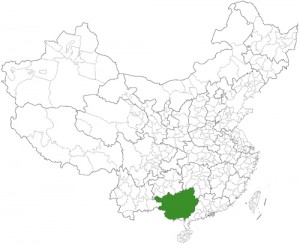Like its northern cousin Guizhou, Guangxi is one of the poorer regions of China. Yet, unlike Guizhou, the tourism industry in Guangxi is huge and many of the region’s cities economically depend upon tourism. Guangxi is rich in cultural heritage sites, stunning natural scenery, and adventure tourism, making it the perfect place to travel and get a taste of what southern China is like. Although it was formerly a province, in 1958 it was changed into an autonomous region and its full name is in fact Guangxi Zhuang Autonomous Region, as the region is home to over 90% of the country’s Zhuang population.
The name “Guangxi” dates all the way back to the Song Dynasty (960–1279), although back then it was known as “Guangnan Xilu” or “Wide Northwestern Road”. During the Yuan Dynasty (1206–1368), the name was abbreviated to “Guangxi”, which simply means “Western Expanse” in Chinese and was intended to match its eastern cousin Guangdong (“Eastern Expanse”). The name can be further abbreviated to “Gui”, which derives from the former provincial capital of Guilin.
Guangxi is bordered by Yunnan to the west, Guizhou to the north, Hunan to the northeast, and Guangdong to the east and southeast. It also borders Vietnam in the southwest. The region is relatively mountainous, although not quite as mountainous as Guizhou. Guangxi is characterised by its many beautiful rivers, the most famous of which is the Li River. Since it is so far south, Guangxi has a subtropical, monsoon climate that verges on being almost tropical. In the summer the temperature can reach peaks of up to 29°C and in the winter it can drop to between 6°C and 16°C. The rainfall in Guangxi is primarily concentrated in spring and summer, with 80% of its rain falling between April and September each year. The climate in Guangxi makes it perfect for plant-life and the region supports a wealth of lush, tropical greenery throughout the year.
Although the Han Chinese are the largest ethnic group in Guangxi, the area is also home to over 14 million people of the Zhuang ethnic minority. There are also significant numbers of people from the Dong and Miao ethnic minorities and smaller populations of Yao, Hui, Yi, and Shui people. This melting pot of ethnicities, along with Guangxi’s proximity to Guangdong, has deeply impacted the region’s culture. In eastern Guangxi, much of the culture and language has been heavily influence by Cantonese culture, which made its way into Guangxi via the Xi River Valley in Guangdong. Nowadays the most noticeable effect of this ethnic diversity is the linguistic diversity of the region. In the city of Nanning alone, three different dialects of Chinese are spoken, along with various Zhuang languages and languages of other ethnic minorities.
 Although Nanning is the capital of Guangxi, Guilin is considered to be the best place for tourism. Guilin boasts access to some of China’s most famous tourist attractions, including the Li River, the Karst Mountains and the Dragon’s Backbone Rice Terraces of Longsheng. However, a trip to Guangxi wouldn’t be complete without a trip to Guangxi Museum in Nanning or the Silver Beach of Beihai. With its lush forests, towering mountains, complex ethnic heritage, and powdery white beaches, Guangxi has something to suit everyone.
Although Nanning is the capital of Guangxi, Guilin is considered to be the best place for tourism. Guilin boasts access to some of China’s most famous tourist attractions, including the Li River, the Karst Mountains and the Dragon’s Backbone Rice Terraces of Longsheng. However, a trip to Guangxi wouldn’t be complete without a trip to Guangxi Museum in Nanning or the Silver Beach of Beihai. With its lush forests, towering mountains, complex ethnic heritage, and powdery white beaches, Guangxi has something to suit everyone.
Join a travel with us to explore more about Guangxi Province: Explore the culture of Ethnic minorities in Southeast Guizhou
One Reply to “Guangxi”